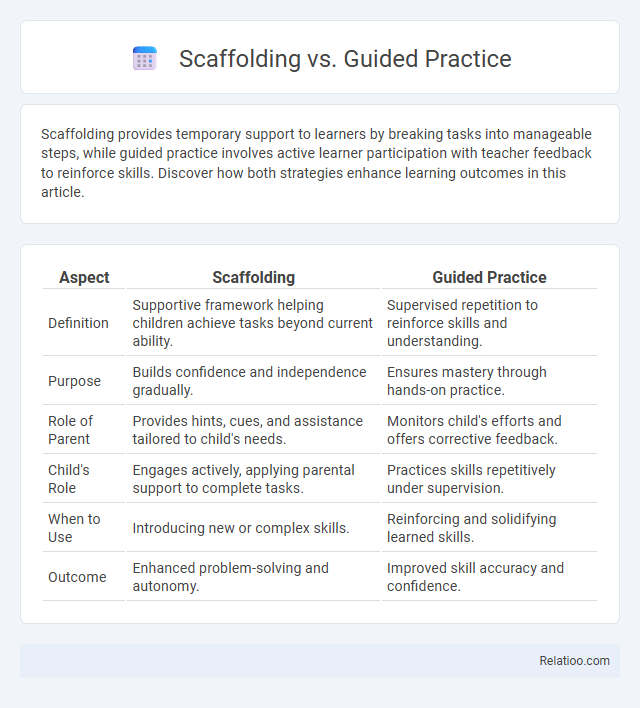Scaffolding provides temporary support to learners by breaking tasks into manageable steps, while guided practice involves active learner participation with teacher feedback to reinforce skills. Discover how both strategies enhance learning outcomes in this article.
Table of Comparison
| Aspect | Scaffolding | Guided Practice |
|---|---|---|
| Definition | Supportive framework helping children achieve tasks beyond current ability. | Supervised repetition to reinforce skills and understanding. |
| Purpose | Builds confidence and independence gradually. | Ensures mastery through hands-on practice. |
| Role of Parent | Provides hints, cues, and assistance tailored to child's needs. | Monitors child's efforts and offers corrective feedback. |
| Child's Role | Engages actively, applying parental support to complete tasks. | Practices skills repetitively under supervision. |
| When to Use | Introducing new or complex skills. | Reinforcing and solidifying learned skills. |
| Outcome | Enhanced problem-solving and autonomy. | Improved skill accuracy and confidence. |
Introduction to Scaffolding and Guided Practice
Scaffolding in education involves providing temporary support to students to help them achieve learning goals they cannot accomplish independently, gradually removing assistance as competence increases. Guided practice allows learners to apply new knowledge with immediate teacher feedback, reinforcing skills through structured activities before moving to independent tasks. Both strategies are essential for effective skill acquisition, balancing support and autonomy to optimize student learning outcomes.
Defining Scaffolding in Education
Scaffolding in education refers to the instructional strategy where teachers provide successive levels of temporary support to help students achieve higher levels of understanding and skill acquisition. It involves breaking learning into manageable chunks and offering assistance tailored to each student's current skill level, gradually removing support as competence increases. This approach contrasts with guided practice, which emphasizes structured repetition of skills after initial instruction, and direct instruction without adaptive, personalized support.
Understanding Guided Practice in Teaching
Guided practice in teaching emphasizes active student engagement with teacher support, bridging independent work and direct instruction. This phase allows learners to apply skills with immediate feedback, promoting deeper understanding and retention. Scaffolding provides tailored assistance that gradually fades, while guided practice specifically focuses on structured opportunities for students to practice new concepts under teacher guidance.
Key Differences Between Scaffolding and Guided Practice
Scaffolding provides structured support tailored to your learner's needs, gradually withdrawn as competence increases, while guided practice involves learners actively applying skills with teacher feedback after initial instruction. Scaffolding emphasizes breaking tasks into manageable parts with modeled strategies, whereas guided practice focuses on repeated practice to reinforce understanding and build independence. Both approaches aim to enhance learning, but scaffolding is more dynamic, adapting support levels, unlike the more consistent guidance during guided practice.
Benefits of Scaffolding for Learners
Scaffolding offers significant benefits for learners by providing structured support that gradually fades as competence increases, enhancing understanding and independence. This approach enables personalized guidance that targets individual learner needs and promotes confidence in mastering complex tasks. Scaffolding also improves information retention and critical thinking by breaking down learning into manageable steps, unlike guided practice which typically involves more direct teacher involvement.
Advantages of Guided Practice in the Classroom
Guided practice promotes active student engagement by allowing learners to apply new concepts with teacher support, reinforcing understanding and correcting misconceptions in real-time. This method fosters confidence and autonomy by gradually shifting responsibility from instructor to student, enhancing skill retention and transfer. Frequent feedback during guided practice enables differentiated instruction, meeting diverse learning needs and improving overall academic achievement.
Practical Examples of Scaffolding Strategies
Practical examples of scaffolding strategies include using graphic organizers to help students structure their ideas, modeling problem-solving steps in math, and providing sentence starters during writing tasks. Guided practice involves teacher-led activities where students apply new concepts with support, such as solving problems together and receiving immediate feedback. Scaffolding gradually removes this support as learners gain independence, ensuring skills are internalized effectively and promoting long-term retention.
Guided Practice Techniques for Effective Learning
Guided practice techniques enhance learning by providing structured support while allowing students to actively engage with new material, promoting skill mastery and confidence. Effective strategies include modeling tasks, prompting students with targeted questions, and offering immediate feedback to correct errors and reinforce understanding. These methods bridge the gap between direct instruction and independent performance, optimizing knowledge retention and application.
Choosing the Right Approach: Scaffolding vs Guided Practice
Choosing the right approach between scaffolding and guided practice depends on the learner's skill level and task complexity, with scaffolding providing temporary support to bridge knowledge gaps and guided practice offering structured opportunities for independent application. Scaffolding techniques include modeling, prompting, and questioning to gradually transfer responsibility, while guided practice emphasizes repetition and reinforcement under teacher supervision to build confidence and competence. Effective instruction integrates both methods by initially employing scaffolding to introduce new concepts and transitioning to guided practice to solidify understanding and mastery.
Conclusion: Integrating Scaffolding and Guided Practice
Integrating scaffolding and guided practice enhances learning by providing structured support while gradually promoting independence, ensuring Your mastery of complex skills. Scaffolding offers tailored assistance to bridge knowledge gaps, and guided practice reinforces understanding through active, supervised application. This combined approach optimizes educational outcomes by balancing support and autonomy for effective skill acquisition.

Infographic: Scaffolding vs Guided Practice
 relatioo.com
relatioo.com